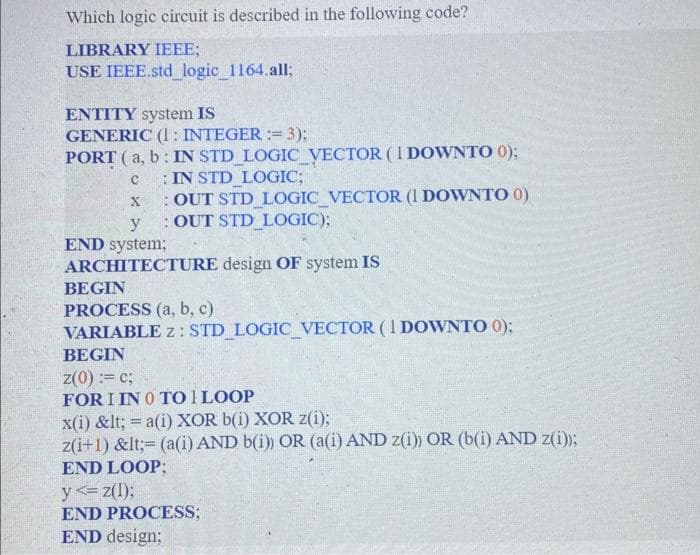Which logic circuit is described in the following code? LIBRARY IEEE; USE IEEE.std_logic_1164.all; ENTITY system IS GENERIC (1: INTEGER := 3); PORT (a, b: IN STD_LOGIC_VECTOR (1 DOWNTO 0); : IN STD_LOGIC; C X y END system; ARCHITECTURE design OF system IS : OUT STD_LOGIC_VECTOR (1 DOWNTO 0) : OUT STD_LOGIC); BEGIN PROCESS (a, b, c) VARIABLE z: STD_LOGIC_VECTOR (1 DOWNTO 0); BEGIN z(0) := c; FOR I IN 0 TO LOOP x(i) < = a(i) XOR b(i) XOR z(i); z(i+1) <= (a(i) AND b(i)) OR (a(i) AND z(i)) OR (b(i) AND z(i)); END LOOP; y <= z(l); END PROCESS; END design;
Which logic circuit is described in the following code? LIBRARY IEEE; USE IEEE.std_logic_1164.all; ENTITY system IS GENERIC (1: INTEGER := 3); PORT (a, b: IN STD_LOGIC_VECTOR (1 DOWNTO 0); : IN STD_LOGIC; C X y END system; ARCHITECTURE design OF system IS : OUT STD_LOGIC_VECTOR (1 DOWNTO 0) : OUT STD_LOGIC); BEGIN PROCESS (a, b, c) VARIABLE z: STD_LOGIC_VECTOR (1 DOWNTO 0); BEGIN z(0) := c; FOR I IN 0 TO LOOP x(i) < = a(i) XOR b(i) XOR z(i); z(i+1) <= (a(i) AND b(i)) OR (a(i) AND z(i)) OR (b(i) AND z(i)); END LOOP; y <= z(l); END PROCESS; END design;
Computer Networking: A Top-Down Approach (7th Edition)
7th Edition
ISBN:9780133594140
Author:James Kurose, Keith Ross
Publisher:James Kurose, Keith Ross
Chapter1: Computer Networks And The Internet
Section: Chapter Questions
Problem R1RQ: What is the difference between a host and an end system? List several different types of end...
Related questions
Question
solve fast

Transcribed Image Text:Which logic circuit is described in the following code?
LIBRARY IEEE;
USE IEEE.std_logic_1164.all;
ENTITY system IS
GENERIC (1: INTEGER := 3);
E
PORT (a, b: IN STD_LOGIC_VECTOR (I DOWNTO 0);
IN STD_LOGIC;
C
X : OUT STD_LOGIC_VECTOR (1 DOWNTO 0)
y OUT STD_LOGIC);
END system;
ARCHITECTURE design OF system IS
BEGIN
PROCESS (a, b, c)
VARIABLE z: STD_LOGIC_VECTOR (1 DOWNTO 0);
BEGIN
z(0) := c;
FOR I IN 0 TO 1 LOOP
x(i) < = a(i) XOR b(i) XOR z(i);
z(i+1) <= (a(i) AND b(i)) OR (a(i) AND z(i)) OR (b(i) AND z(i));
END LOOP;
y <= z(l);
END PROCESS;
END design;
Expert Solution
This question has been solved!
Explore an expertly crafted, step-by-step solution for a thorough understanding of key concepts.
Step by step
Solved in 3 steps

Recommended textbooks for you

Computer Networking: A Top-Down Approach (7th Edi…
Computer Engineering
ISBN:
9780133594140
Author:
James Kurose, Keith Ross
Publisher:
PEARSON

Computer Organization and Design MIPS Edition, Fi…
Computer Engineering
ISBN:
9780124077263
Author:
David A. Patterson, John L. Hennessy
Publisher:
Elsevier Science

Network+ Guide to Networks (MindTap Course List)
Computer Engineering
ISBN:
9781337569330
Author:
Jill West, Tamara Dean, Jean Andrews
Publisher:
Cengage Learning

Computer Networking: A Top-Down Approach (7th Edi…
Computer Engineering
ISBN:
9780133594140
Author:
James Kurose, Keith Ross
Publisher:
PEARSON

Computer Organization and Design MIPS Edition, Fi…
Computer Engineering
ISBN:
9780124077263
Author:
David A. Patterson, John L. Hennessy
Publisher:
Elsevier Science

Network+ Guide to Networks (MindTap Course List)
Computer Engineering
ISBN:
9781337569330
Author:
Jill West, Tamara Dean, Jean Andrews
Publisher:
Cengage Learning

Concepts of Database Management
Computer Engineering
ISBN:
9781337093422
Author:
Joy L. Starks, Philip J. Pratt, Mary Z. Last
Publisher:
Cengage Learning

Prelude to Programming
Computer Engineering
ISBN:
9780133750423
Author:
VENIT, Stewart
Publisher:
Pearson Education

Sc Business Data Communications and Networking, T…
Computer Engineering
ISBN:
9781119368830
Author:
FITZGERALD
Publisher:
WILEY